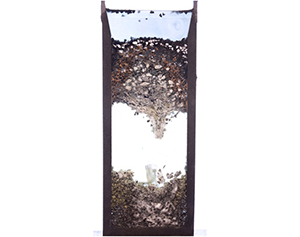Published online by Cambridge University Press: 26 October 2020

We consider the flow of a thermoviscous fluid within a vertical tube which is heated from below, modelling a scenario where a fluid melts, flows and eventually drips due to a temperature-dependent viscosity. To do so, we develop a two-dimensional axisymmetric model comprising three regions, a solid granular upper region (modelled as a region of hydrostatic pressure), a middle highly viscous ‘crust’ region which flows and a lower cavity region within which the material can drip. New material is continuously added to the top, yet the highly viscous middle region can slow mass transfer from the top region to the cavity if it becomes too thick or does not drip fast enough. In the limit of a tall, thin geometry, akin to what is often seen in industrial applications, the resulting model comprises a moving boundary problem governed by an energy equation with a Stefan condition, both subject to a non-local radially averaged convective term. We carry out numerical simulations and an asymptotic analysis of the model in this tall, thin limit, for a variety of physically relevant parameter regimes. Our results reveal a variety of qualitatively different behaviours, and enable us to explore how various parameter regimes influence the salient features of the flow, including the ‘crust’ thickness and the flux of material through the lower moving boundary.